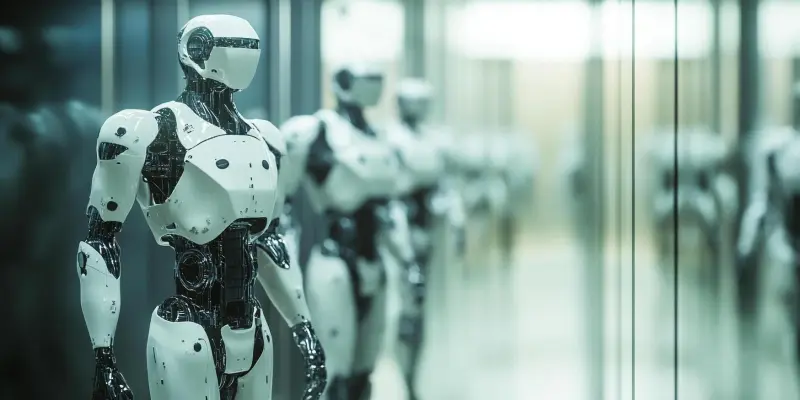Manufacturing jobs in the United States have long migrated overseas, driven by the allure of lower labor costs and scalable production capacities. The prevalent sentiment within the industry is that bringing these jobs back to American soil faces formidable challenges, particularly the high cost of domestic labor. Today’s technological advancements, however, offer a powerful tool that could make reshoring a feasible reality: AI-powered robots. Automation, particularly through artificial intelligence, stands as a solution that can cost-effectively revolutionize manufacturing, outweighing costs that previously favored international locations. The shift, however, transcends mere machinery; it entails a transformation in workforce dynamics where human labor shifts from manual tasks to supervising robotic systems.
Tariffs and American Innovation
The U.S. administration’s strategy to employ tariffs as a catalyst for encouraging domestic innovation and job creation in the manufacturing sector has redefined the landscape. While tariffs aim to level the playing field by making foreign-made goods more expensive, this strategy alone is insufficient to recreate labor-intensive manufacturing jobs. Thus, the integration of AI and robotics emerges as not just beneficial but necessary. Automated systems equipped with artificial intelligence can perform tasks with remarkable precision, speed, and consistency, which human labor struggles to match, especially in high-cost environments. Furthermore, the technological edge provided by few-shot learning, where AI-enabled robots can learn tasks quickly after few demonstrations, is crucial. This advancement reduces the setup times and costs traditionally associated with automation, making it more accessible to various industries.
The role of AI in overcoming manual labor costs cannot be overstated. American manufacturers are poised to benefit from an automation-driven framework where the primary workforce responsibility will shift toward the oversight and optimization of these systems. This redefined work scope implies new job opportunities albeit in segments necessitating different skill sets. Jobs would no longer majorly comprise repetitive assembly tasks but would instead focus on quality control, maintenance, and system improvements—a transformation indispensable in justifying reshoring pursuits despite high domestic labor expenses.
Complex Manufacturing Processes
Addressing the complexities of certain manufacturing processes represents another significant hurdle. Sectors like textile production exemplify industries where precision and adaptability are paramount. Traditionally, such meticulous tasks have depended heavily on skilled human hands. However, the development of AI-enhanced robots capable of high dexterity and adaptive responses promises transformative effects. Unlike conventional automation that struggles with variability, AI advancements equip robots to handle customized instructions and adjust in real time to the nuanced requirements of intricate production. This leap in technology bridges the gap between manual skill and automated efficiency, making it feasible to repatriate these sophisticated manufacturing jobs.
While overcoming the inherent challenges in automating intricate processes, AI-driven robotics ensure productivity enhancement and consistent quality. Textile production illustrates how enhancing robotic capabilities sufficiently to match or exceed human precision in adaptable settings is pivotal. These developments not only potentiate reshoring but also stimulate innovation within sectors typically lagging in automation adoption. Paving the way for complex jobs to return to U.S. shores, AI underpins strategic advancements fostering renewed competitiveness in the global market.
Skilled Labor for Automated Manufacturing
With the rise of automation, the need for a skilled workforce capable of managing advanced robotic systems becomes urgent. This demand necessitates a robust pipeline of talent equipped with the requisite skills to thrive in an automated manufacturing environment. Education institutions and tech companies must collaborate to create comprehensive training programs that prepare future workers for these roles. The semiconductor industry serves as an illustrative example where such collaborations have yielded a well-prepped workforce fluent in operating sophisticated tools and processes. Establishing similar frameworks in other manufacturing sectors ensures that labor shortages do not hinder progress towards reshoring. Training initiatives must encompass hands-on experience with AI systems, proficiency in data analysis, and an understanding of maintenance protocols for robotic equipment. This holistic approach does not just equip the workforce for existing technologies but builds a foundation adaptable to future innovations. Strategic training programs can mitigate the skill gap, leveraging AI automation while fostering employment growth tailored to advanced manufacturing ecosystems. Ensuring a steady stream of adept professionals not only supports automation’s implementation but also solidifies the U.S.’s stance as a leader in technologically advanced manufacturing.
Embracing Automation for Economic Revival
The U.S. administration’s strategic use of tariffs aims to boost domestic innovation and create jobs in the manufacturing sector, dramatically changing the landscape. Tariffs make foreign goods more expensive, providing a level playing field, but alone they can’t bring back labor-intensive manufacturing jobs. Therefore, integrating AI and robotics becomes essential. Automated systems with AI can perform tasks with remarkable precision, speed, and consistency, outperforming human labor, especially in high-cost settings.
Few-shot learning in AI allows robots to quickly learn tasks after a few demonstrations, cutting down setup times and costs associated with automation. This technological advancement makes automation more accessible across various industries, playing a critical role in offsetting manual labor costs. American manufacturers stand to gain from automation-focused frameworks, shifting workforce roles toward overseeing and optimizing these systems. This shift means new job opportunities that require different skill sets, primarily focusing on quality control, maintenance, and system improvements. This transformation is essential to justify reshoring manufacturing despite high domestic labor costs.

